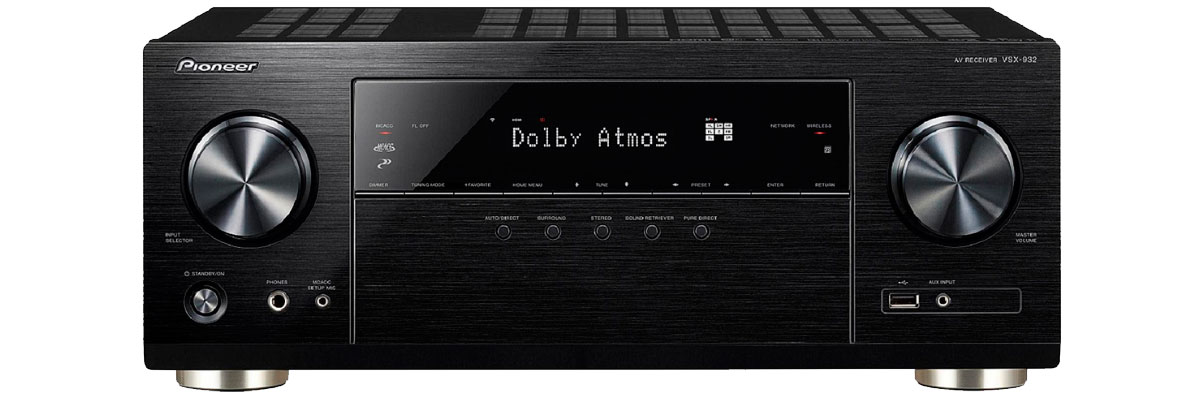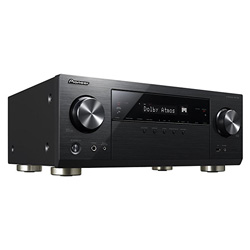 It does not take a lot of money to buy a receiver that can effectively control the full set of Dolby Atmos speakers, including front, center, rear and ceiling speakers, as well as two independent subwoofers. After all, in this Pioneer VSX-932 review we’ll see such features listed in Pioneer VSX-932 specs.
It does not take a lot of money to buy a receiver that can effectively control the full set of Dolby Atmos speakers, including front, center, rear and ceiling speakers, as well as two independent subwoofers. After all, in this Pioneer VSX-932 review we’ll see such features listed in Pioneer VSX-932 specs.
Pioneer VSX-932 review
Features
A headline figure of 130 watts seems impressive, but it’s quoted into six ohms rather than eight, with only one channel running. 130W into six ohms converts, holding output voltage constant to 97.5W into eight ohms. Knock a few more off to get the THD down from 1% and we might estimate the more conventional rating of this receiver would be 90 to 95W per channel. That’s nothing to be ashamed of at this price point, especially as this is a proper 7.1-channel receiver. As we’ll see, there are many ways those seven channels can be deployed, but note at this point that it includes Dolby Atmos and DTS:X. There are seven sets of speaker outputs.
Design and build
The VSX-932 model has all the necessary decoders and seven powerful output stages, which operate on the basis of Pioneer's exclusive Direct Energy technology, which minimizes power consumption and heat generation. And with Atmos-enabled speakers that don't emit sound directly, this model, thanks to the Reflex Optimizer, manages to create surround and surround sound with effects that fit precisely in three dimensions.

Connectivity
The advanced capabilities of the VSX-932 in terms of creating surround sound are complemented by the latest video technology - the four HDMI inputs of this model support 4K / 4: 4: 4 / 60p / 24bit with color space extensions and dynamic extensions HDR10, Dolby Vision and BT.2020. The high-resolution streaming system also works with high-resolution audio and DSD support, which is complemented by the built-in streaming services Tidal, Spotify and Deezer, as well as TuneIn Internet radio. In addition, it is supplemented by WiFi, AirPlay and Bluetooth, and after a future firmware update, it will be supplemented with built-in Chromecast and PlayFi technology.
Setup
The Pioneer Remote App on an iPad showed the signal handling, making it clear that the Atmos was being properly handled.
Pros and Cons
Pros
- Wide network functionality, including Chromecast
- Great speed and ease of setting up. The manual is clearly written
Cons
- Needs a lot of tweaking to be optimized on high end system
Common features
Product
Model
Brand
Reviews
Amplifier
Channels
Stereo power (RMS), W/Ohm
Output impedance, Ohm
Frequency response
THD in stereo, %
Audio features
Digital to analog converter (DAC)
Bi-amping
Pure direct (straight)
Auto speaker calibration
Speaker A/B switching
Other audio features
Connectivity
Wi-Fi
USB
Bluetooth
Ethernet (RJ45)
DLNA
MHL
Streaming services
Apple Music (AirPlay)
Amazon Music
Spotify
Other streaming services
Extensive connection
HDMI input/output
HDMI ARC (Audio Return Channel)
HDMI eARC (Enhanced Audio Return Channel)
HDMI CEC
Digital content protection (HDCP)
Subwoofer output (LFE)
Headphone output
Optical digital input
Coaxial digital input
Composite input
Component input/output
Phono (MM) input
Front panel connectors
Multi channel preamp output
Video features
HDR (High Dynamic Range)
4K signal pass-through
8K signal pass-through
HDMI signal pass-through
3D signal pass-through
HDMI pass-through in standby mode
Video conversion
Analog to HDMI scaling
HDMI to HDMI scaling
Dolby Vision
Other video features
Additional features
Voice control
App control
Display
Tuner
Sleep timer
Auto power off
ECO mode
Graphical user interface (GUI)
Setup assistant
Firmware update
Other additional features
Multi-room
Multi-room zones
Zone audio output
Zone HDMI output
Multi-room control
RS-232
Remote control input/output (IR)
DC trigger output (12V)
Multichannel surround
Dolby Atmos
Dolby TrueHD
Dolby Surround
Dolby (other)
DTS:X
DTS HD Master
DTS Virtual:X
DTS Neural:X
DTS (other)
Auro-3D
IMAX Enhanced
Multichannel stereo
Audio file formats
MP3
WMA
AAC
WAV
FLAC
ALAC
Other audio file formats
Power
Operational power consumption, W
Standby consumption, W
Removable power cord
User manual
Manual
Dimensions
Size W x H x D, cm/inches
Weight, kg/lbs
Other
Release year


